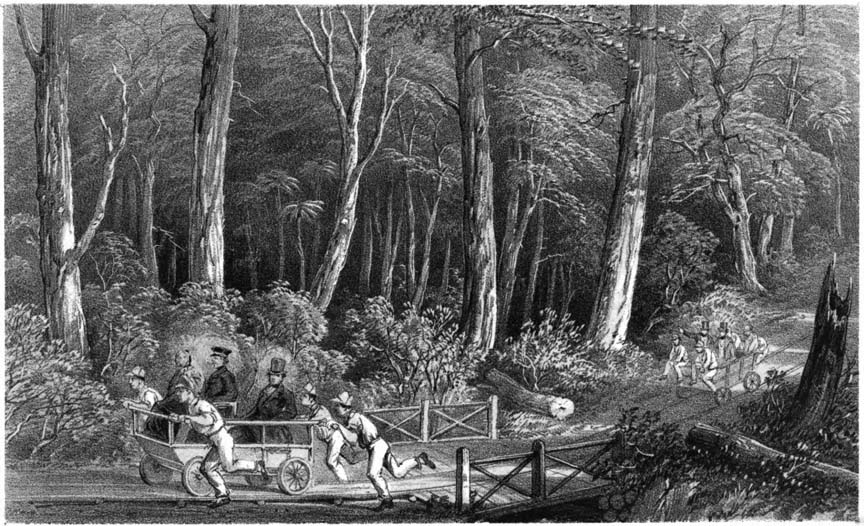What's IotD?
The interesting, amazing, or mind-boggling images of our days.
|
| |
xoxoxoBruce Sunday Jan 3 03:07 AM Jan 3rd, 2016: Footwork Railroad
This picture gave me a WTF moment, because the era of the clothing doesn't jib with any environmentally sound movement, that I know of.
It's Australia in the 1850s, with four men pushing a four seat cart, on wood rails. Damn, that's a hell of a way to make a living.
But they don't have a choice, they're prisoners. Futility Closet says...
Quote:
|
The first passenger railway in Australia was powered by convicts. Four-passenger carts ran on hardwood rails from the dock at the head of Norfolk Bay to the main settlement at Port Arthur, some 4.5 miles away. On steep downhill slopes the carts could reach 30 mph, as observed by Col. Godfrey Mundy on an 1851 visit:
|

Quote:
The prisoners seized certain bars crossing the front and back of the carriages, and after pushing them with great toil up a considerable plane, reached the top of a long descent, when, getting up their steam, down they rattled at tremendous speed tremendous, at least, to lady-like nerves the chains around their ankles chinking and clanking as they trotted along.
[T]he runners jumped upon the side of the trucks in rather unpleasant proximity with the passengers, and away we all went, bondsmen and freemen, jolting and swaying
a man sitting behind contrived, more or less, to lock a wheel with a wood crowbar when the descent became so rapid as to call for remonstrance.
He added, Our poor beasts of burthen at the end of the traject seemed terribly jaded, running down with sweat, and saw one of them continually trying to shift his irons from a galled spot on his ankle. On the return journey that afternoon, the leader asked whether they might stop briefly, as the men had had nothing to eat for 12 hours.
|
This was the first, but not only, railroad of it's type.
Quote:
|
After visiting a similar railway at Ralph Bay Neck in 1847, Lt.-Gov. Sir William Denison wrote, I must say that my feelings at seeing myself seated, and pushed along by these miserable convicts, were not very pleasant. It was painful to see them in the condition of slaves, which, in fact, they are, waiting for me up to their knees in water.
|
In the late 1850s Britain stopped shipping prisoners because a number of objections by various groups. None of the objections weighed were humanitarian, only practical. The convict ships resupplied in the Canaries, Rio, Cape town, and some alternates, even India. which had problems from time to time. Concerns over the ratio of prisoners to settlers worried some, so the shipments tapered off until the last ship in 1868
No happily ever after however, because when the convicts dried up blackbirding took it's place.
Quote:
|
Between 1842 and 1904 more than 60,000 men and boys from the South Pacific islands, and an unknown number of women and girls, were kidnaped and brought to Australia to work as slaves on the sugar plantations that still dot the country's northeast coast.
|
But that's a whole different can of worms. 
Diaphone Jim Sunday Jan 3 12:21 PMToo bad the Olympics hadn't gotten started again by then. Australia would have had some killer four-man bobsled teams.
It seems that things are not much different today, just less photogenic.
Your reply here?
The Cellar Image of the Day is just a section of a larger web community: a bunch of interesting folks talking about everything. Add your two cents to IotD by joining the Cellar.
|
|
|
|
|
|


